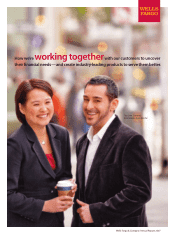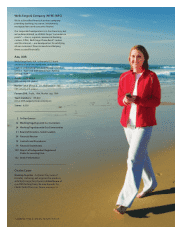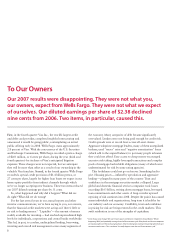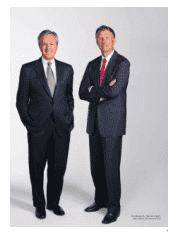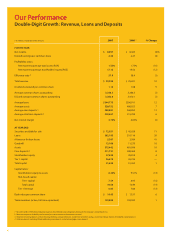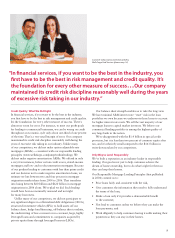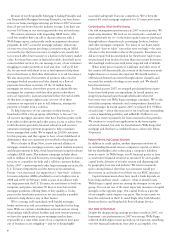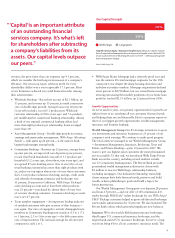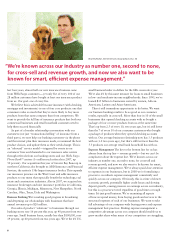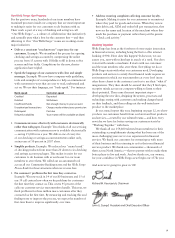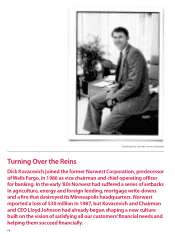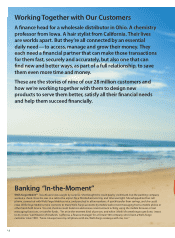Wells Fargo 2007 Annual Report Download - page 4
Download and view the complete annual report
Please find page 4 of the 2007 Wells Fargo annual report below. You can navigate through the pages in the report by either clicking on the pages listed below, or by using the keyword search tool below to find specific information within the annual report.
2
First, in the fourth quarter Visa Inc., the world’s largest credit
and debit card provider, completed its global restructuring and
announced it would be going public, contemplating an initial
public offering early in 2008. Wells Fargo owns approximately
2.8 percent of Visa. With the concurrence of the U.S. Securities
and Exchange Commission, Wells Fargo recorded a pretax charge
of $203 million, or 4 cents per share, during the year (third and
fourth quarters) for its share of Visa’s anticipated litigation
expenses. These charges were not expected, but we anticipate
they will be more than offset as a result of our ownership in the
valuable Visa franchise. Second, in the fourth quarter Wells Fargo
recorded a special credit provision of $1.4 billion pretax, or
27 cents per share, largely for higher loan losses we expect in our
home equity portfolio from indirect channels through which
we’re no longer accepting new business. These two items reduced
our 2007 diluted earnings per share by 31 cents.
So, what happened and why did it happen? What did we
do right? What did we do wrong?
For the last several years in our annual reports and other
investor communications, we’ve been saying to you, our owners,
that the financial credit markets were acting as if there’s little or
no risk to lending money.* “Liquidity” — the amount of money
readily available for investing — had reached unprecedented high
levels for individuals, corporations and central banks worldwide.
This led, in part, to careless, undisciplined lending, borrowing,
investing and overall risk management across many segments of
the economy. Many categories of debt became significantly
overvalued. Lenders were not being paid enough for credit risk.
Credit spreads were at record lows across all asset classes.
Aggressive subprime mortgage lenders, many of them unregulated
brokers, used “teaser” rates and “negative amortization” loans
(which add to the unpaid balance) to put many people in homes
they could not afford. Easy access to cheap money encouraged
excessive risk taking, highly leveraged transactions and complex
pools of mortgage-backed debt obligations (many of which were
underestimated for risk by some rating agencies).
This foolishness could not go on forever. Something had to
give. Housing prices — inflated by speculation and aggressive
lending — plunged in many parts of the country. Trust and
confidence in the mortgage securities market collapsed. Large
global and domestic financial services companies took losses
exceeding $163 billion, writing down mortgage loans, leveraged
loan commitments and other assets. A long-overdue upward
repricing of risk continues into 2008. Despite the pain it has caused
many individuals and organizations, long term it is healthy for
our industry and our economy. Credibility, trust and confidence
in pricing for risk are being restored in the credit markets. This
swift retribution is one of the strengths of capitalism.
To Our Owners
Our 2007 results were disappointing. They were not what you,
our owners, expect from Wells Fargo. They were not what we expect
of ourselves. Our diluted earnings per share of $2.38 declined
nine cents from 2006. Two items, in particular, caused this.
* Some things never change! We said 10 years ago in our Norwest Corporation Annual Report, “What’s
happening? Well, we’re probably nearing the end of this economic cycle. Many banks and finance companies
are not pricing for risk. They’re chasing bad loans. They’re relaxing loan covenants beyond prudent levels just
to attract more business. This is irrational. It usually happens near the end of an economic cycle.”

